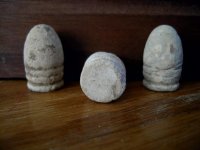WVDirtfisher
Senior Member
It has been too cold to detect, so I figured that I could do some research on some relics. Come to find out I have found a rather rare bullet. Thanks for lookin!! Bullets in photo are from my collection. Information from Antique Arms Inc.
7th West Virginia came right through were I have been diggin!
Even better, we even know the two units to receive all the 1st Model Lindners with 391 going to the 1st Michigan Cavalry in Nov. 1861 followed by an additional 501 going to the New York Arsenal in Jan. 1863. By Spring, this group of 1st Models had been transferred to the Wheeling, West Virgina Ordnance depot. Many Lindners in this second group were issued to the 8th West Virginia Mounted Infantry in June 1863 which later became the 7th West Virginia Cavalry in Jan. 1864. The 8th saw their first action with the Lindner Carbine on August 26-27 1863 in a skirmish against Confederate Forces near Whilte Sulphur Springs, West Virgina where it suffered 2 killed, 16 wounded, and 3 missing. On September 30, 1863, the 8th West Virginia Mounted Infantry reported the following numbers of Lindners in the field per Company:
Co. A 49
Co. D 41
Co. G 42
Co. H 49
Co. I 41
Co. K 36
In storage 39
Total 297 Lindners
The 8th was involved in another engagement on Droop Mountain in Nov. 1863. After becoming the 7th WV Cavalry, an inventory taken the following year of all Union Cavalry regiements was performed during the summer and fall of 1864. It shows the 8th...now the 7th Cavalry with over 80 Burnsides and only 41 Lindner Carbines remaining in use. It appears that most Lindner's did not stay in the field for very long during the war.
7th West Virginia came right through were I have been diggin!
Even better, we even know the two units to receive all the 1st Model Lindners with 391 going to the 1st Michigan Cavalry in Nov. 1861 followed by an additional 501 going to the New York Arsenal in Jan. 1863. By Spring, this group of 1st Models had been transferred to the Wheeling, West Virgina Ordnance depot. Many Lindners in this second group were issued to the 8th West Virginia Mounted Infantry in June 1863 which later became the 7th West Virginia Cavalry in Jan. 1864. The 8th saw their first action with the Lindner Carbine on August 26-27 1863 in a skirmish against Confederate Forces near Whilte Sulphur Springs, West Virgina where it suffered 2 killed, 16 wounded, and 3 missing. On September 30, 1863, the 8th West Virginia Mounted Infantry reported the following numbers of Lindners in the field per Company:
Co. A 49
Co. D 41
Co. G 42
Co. H 49
Co. I 41
Co. K 36
In storage 39
Total 297 Lindners
The 8th was involved in another engagement on Droop Mountain in Nov. 1863. After becoming the 7th WV Cavalry, an inventory taken the following year of all Union Cavalry regiements was performed during the summer and fall of 1864. It shows the 8th...now the 7th Cavalry with over 80 Burnsides and only 41 Lindner Carbines remaining in use. It appears that most Lindner's did not stay in the field for very long during the war.




